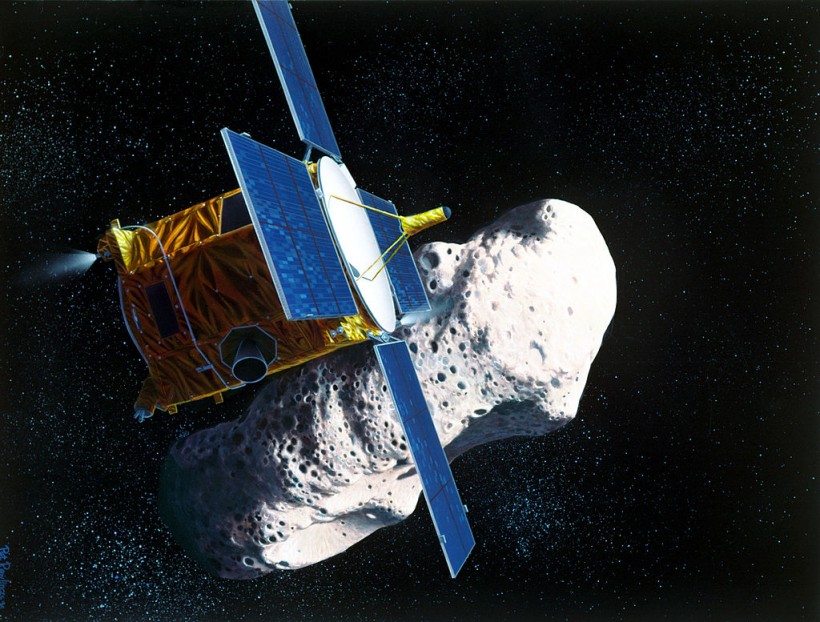An asteroid that measures a little over half a mile wide, bigger than any building on Earth, is to fly by Earth and through the inner solar system, with a proximity close enough to our planet that even backyard astronomers can get a glimpse.
The asteroid flyby of the giant Asteroid 1994 PC1 is set to cruise past our cosmic corner on Tuesday, Jan. 18. The space rock is more than a kilometre wide at 1,052m (3,451ft), bigger than the Burj Khalifa in Dubai which, at 830m (2,723ft), is the world's tallest building.
In addition, it will travel a distance of of 1.2 million miles (1.93 million kilometers) from Earth, more than five times the distance between our planet and the moon, so no need to freak out.
"Near-Earth asteroid 1994 PC1 is very well known and has been studied for decades by our planetary defense experts," NASA tweeted Wednesday. "Rest assured, 1994 PC1 will safely fly past our planet."
Asteroid 1994 PC1 Close Encounter with Earth

385446 04: UNDATED FILE PHOTO: An artist's rendering of the Near Earth Asteroid Rendezvous (NEAR) spacecraft's rendezvous with the asteroid Eros. After a year of circling and taking pictures, NEAR will touch down on asteroid Eros February 12, 2001, to capture surface details, which will be the first time any craft has tried to land on a tumbling space rock.
Asteroid (7482) 1994 PC1 was first discovered at the Siding Spring Observatory in Australia on August 9 1994 by Robert McNaught, a Scottish-Australian astronomer at the Research School of Astronomy and Astrophysics of the Australian National University.
Asteroids passing by Earth happens all the time, pretty much every day, in fact. The agency's Planetary Defence Coordination Office and NASA monitors skies to find and track thousands of near-Earth objects, and makes sure to intercept potentially hazardous asteroids with its double asteroid redirection test (Dart) mission. Dart mission aims to prove a spacecraft can autonomously navigate a "killer" asteroid by intentionally colliding with it, smashing it off course.
1994 PC1 sure was gigantic, but "by no means is it unprecedented."
Also read: First Full Moon 'Ice Moon' of 2022 to Rise on Martin Luther King, Jr.'s Birthday
When asteroids are considered "killer"
Astronomers had created their own way of creating a very big catalog of objects worth keeping an eye on, thus the phrases "near-earth object"(NEO) and "potentially hazardous asteroid" (PHA). These astronomical terms have very specific definitions that allow them to categorize space objects. For example, if an asteroid comes within 4.6 million miles of Earth and has a certain brightness, it makes the list of PHAs. This is how each asteroid is evaluated as to how "potentially hazardous" it is before giving it that designation.
Meanwhile, NEOs fall into an even broader category. "If you were to leave Earth and travel in the direction of Mars' orbit around the sun, then stop when you're about 85% of the way to the red planet, everything between that position and the sun could technically be considered an NEO," according to Cnet.
Given the mind-blowing scale of the universe, for non-scientists, calling an asteroid "near" when it's farther away from us than any human has ever traveled seems a bit strange. However, it makes sense to call them that in the context of the vastness of space.
The stony giant 1994 PC1 cruise at a sizzling 43,754 miles per hour, relative to Earth. With that speed, it can be observable using backyard telescopes of about 6 inches or wider in diameter. For easier detection, it is better to use some sort of skywatching software like Stellarium or a website like In The Sky.
Also read: Space Anemia: Space Travel Can Destroy 3 Million Red Blood Cells Per Second
© 2024 NatureWorldNews.com All rights reserved. Do not reproduce without permission.





